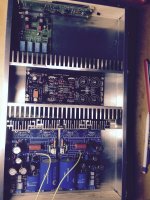I leave mine 24/7.
Other than using a hair dryer to speed warm up time, I can not think of anything else!
Other than using a hair dryer to speed warm up time, I can not think of anything else!
If like me having dual secondarys serialed for full power, I wonder what would happen if I used relays to give the boards half their voltage on standby. I guess the answer is they would stop shunting and go cold.
Last edited:
Running the shunts say at 50mA standby instead of 100mA each with some relay switching R1x CCS set values? Naah, wimpy. Only if hot rod.
Running the shunts say at 50mA standby instead of 100mA each with some relay switching R1x CCS set values? Naah, wimpy. Only if hot rod.
Well why not? I'm boxing it with a dcb1 and I was thinking exactly the same there. Just to keep some temp in the box over night.
If its just for keeping inbox ambient warm, then why not burn some power element like an independent resistor(s) or an iron heater without engaging the circuits at all. Far less complicated and ugly modding.
Is those "no signal"-detectors harmful to the sound in any way? Just a circuit that smacks a relay after 20 min no signal. Can even trigger some slave on the poweramps. Serial a similar value with a relay on the FSPs and the DCB1 and a 12 V master to other units.
Like those in powered subwoofers? On first look they should be benign. Must be detecting the input signal over a high impedance in parallel, but I never evaluated them in a full range main feed context.
If its just for keeping inbox ambient warm
Well it would be beautiful to think of mother nature and go down in current also but you were thinking shutting off the circuits and engage some heat giving elements?
Do you think its mostly about the 369 tempo or are the regs involved getting heat up for themselves in startup cycle?
A TO-220 or 247 resistor of appropriate value fed with a few watts on a copperplate close to the heat sensitive comps would to the trick simple i guess.
Depends on how big is the box and how cold is usually the room, but yes, power resistor(s) its the first technique we mentioned. Oven oscillators do that. The 369s just wander due to their low output impedance and very high transconductance, there is no zero tempco cross section of curves in such devices to bias them fixed. But their temperature gets to cruising level fast, since they are small bugs and we run them near IDSS. Its mostly the ambient that settles and then they settle. Takes half an hour to get a full circuit warm enough anyway.
Well as far as me and the hangarounds has experienced so far they are spot on. Very hard to say what design feature or component that is doing what but the FSP together with the the dyna 10x5 it is a pleasant experience
I see. I use 8.2 Ohm now calculated for 13.49/13.53 IDSS on Q1 and Q2.
The close value that I find in Mouser is 11.1 Ohm Vishay RC55 1/8W (0.1% 22ppm/C). It is OK for W rating?
Hi Nick,
Long story short... I dropped 11.2R for R2&3. No change and same RF. 1uH show the same story with radio and noise in high volume.
After 11.2R installation my max achievable B+ is 32.6V. Hope it is OK since it is a bit below min mentioned in manual.
Noise and RF is definitely coming from TT since disconnection of it show quietness. It is also quite with I connect only L or R from TT.
Both connected create that noise. One connected and second in my hand create radio station hearing session.
All resolved by installing my 1:5 step-up transformer between TT and FSP. Absolutely quite!!!!… and no buzz.
I play music and it is nice to hear it clearly with no any background interference.
Any ideas?
If not, then I’ll might leave my step-us inside as input trany.
32.6V is normal since R2, R3 are now slightly high.
The transformer isolates and makes the TT cable run balanced as the cart coils allow, if its of the balanced impedance floating primary kind so it gets rid of interference on the TT cable. Also it usually has less bandwidth than the electronics and filters RF. After trying 1uH coil even, I tend to think the problem is less relative to what you do at the phono side of things. What about the woofing? That stopped too, seeming related? Was there any interference hint before changing the internals of your cart? Since your X5 SUT does not overload the high sensitivity FSP version (proves quite good margin in practice for that) and solves weirdness in your installation, why not leave it in. If there is no compromise in the transparency department that you can feel, surely.
The transformer isolates and makes the TT cable run balanced as the cart coils allow, if its of the balanced impedance floating primary kind so it gets rid of interference on the TT cable. Also it usually has less bandwidth than the electronics and filters RF. After trying 1uH coil even, I tend to think the problem is less relative to what you do at the phono side of things. What about the woofing? That stopped too, seeming related? Was there any interference hint before changing the internals of your cart? Since your X5 SUT does not overload the high sensitivity FSP version (proves quite good margin in practice for that) and solves weirdness in your installation, why not leave it in. If there is no compromise in the transparency department that you can feel, surely.
- Home
- Source & Line
- Analogue Source
- Simplistic NJFET RIAA
